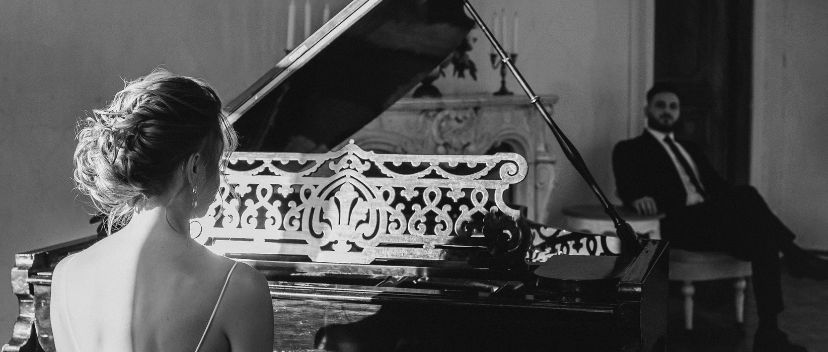Retirement presents the perfect opportunity to start piano lessons. With time to practice and the benefits of improved mental agility, it's never too late to learn an instrument. Setting realistic goals and savoring the joy of creating music can be a fulfilling experience in retirement...
How to Tune a Piano to Hit the Right Note Every Time

If you’ve ever wondered, “How do I tune my own piano?” then this guide is for you. Piano tuning is a delicate process that requires patience, precision, and a good ear.
Whether you’re working with an upright piano or a grand piano, the basic principles of keeping your piano tuned remain the same.
The Fundamentals of Piano Tuning
Before we dive into the details, let’s understand the basics. A piano tuning lever, also known as a tuning hammer, is the primary tool used in the tuning process. It’s used to adjust the tension of the strings by turning the tuning pins.
These pins are embedded in the pinblock inside the piano and hold the strings in place at the desired pitch.
The tuning process involves adjusting the tension of the strings until they vibrate at the correct frequency. This is typically done using an electronic tuning device or an electronic chromatic tuner, which helps to precisely measure the frequency of the string’s vibrations. However, professional piano tuners often rely on their trained ears to fine-tune each string.
Preparing to Tune Your Piano
Before you start, you’ll need some basic tools. Aside from your piano tuning lever, you’ll also need rubber wedge mutes and a treble mute to isolate specific strings during the tuning process. Quality tools are essential for successful piano work, so invest in decent piano tuning tools if you plan on tuning your own piano regularly.
You’ll also need a reference tone to start the tuning process. Middle C is often used as the starting point. You can get this reference tone from an electronic tuner or a tuning fork. If you don’t have these, guitar tuners can also provide the reference tone you need.
Starting the Tuning Process
Begin with the middle strings octave of your piano, focusing first on the A440 (the A above middle C). This is the standard pitch reference used worldwide. Use your electronic tuner to set this string to the correct pitch.
Move on to the other strings in the unison (the two strings or three strings that make the same note). Use your rubber mutes to silence the outer strings while you tune the center string, then remove the mute and tune the other strings to match. Listen carefully to ensure all the notes in the unison match perfectly.
Moving to Other Octaves
Once you’ve tuned the entire middle octave, move on to the adjacent octaves. Tune these strings relative to the ones you’ve already tuned. This is known as the “equal temperament” model of tuning, where each half-step between notes has the same frequency ratio.
The Challenges of Tuning
Tuning a piano isn’t without challenges. It’s easy to turn the wrong pin or pluck the wrong string, which can throw off your tuning process. Also, turning the tuning pins too forcefully can break strings, especially the bass strings, which are under high tension. Therefore, always turn the lever clockwise gently and gradually.
Fine-Tuning Your Piano
After you’ve gone through all the notes, it’s time to fine-tune your work. Go back to middle C and play each note, listening carefully for any discrepancies. Adjust any strings that don’t sound right, using your electronic tuning device or your good ear to guide you.

FAQ: How to Tune a Piano
What is piano tuning?
Piano tuning is the process of adjusting the tension of strings on a piano to ensure that each note plays at the right pitch. Tuning is critical to ensuring that the piano produces a clear and accurate sound.
After all, you’ve put in the time to learn how to play piano – you want to keep it sounding its best!
Can you tune a piano yourself?
It is possible to tune a piano yourself, but it is not recommended unless you have experience and knowledge of piano tuning. A decent piano tuner will be able to tune a piano accurately and safely.
What equipment do I need to tune a piano?
To tune a piano, you will need a tuning lever, tuning pins, a tuning hammer, and a chromatic tuner. Professional tuners may also use tuning forks or electronic tuning software.
How often should a piano be tuned?
Ideally, a piano should be tuned at least twice a year, depending on usage and environmental conditions. Professional tuners can advise on the best tuning schedule for your piano.
Can upright pianos be tuned?
Yes, upright pianos can be tuned just like grand pianos. The process is similar, but the access to the strings and pins may be different.
How do professional tuners tune a piano?
Professional tuners use a combination of their ear and specialized equipment to tune each string of the piano. They start with the middle C and work their way through the entire instrument, tuning the strings in unison and in relation to each other.
What are tuning pins?
Tuning pins are the metal pins that hold the strings in place on a piano. They are crucial to the tuning process, as they must be securely in place for the whole piano to stay in tune.
Can tuning pins ever become loose or fail?
Yes, over time, tuning pins can become loose or fail. This can cause the piano to fall out of tune more quickly or even prevent it from being tuned at all. A professional tuner can assess and repair any issues with the tuning pins.
Can I use a guitar tuner to tune a piano?
While it is technically possible to use a guitar tuner, it is not recommended. Guitar tuners are not designed for the range of notes and strings on a piano and may result in inaccurate tuning.
What is the treble mute and how is it used?
The treble mute is a device used by professional tuners to isolate certain strings while tuning. It allows the tuner to focus on one string area of the piano without being distracted by other strings. The treble mute is usually placed on the strings above middle C.
When to Call a Professional
While many people can learn to tune a piano, there are times when calling in a professional piano technician is the best course of action.
A professional piano tuner has years of training and experience that allow them to handle complex tuning jobs and perform repairs that might be necessary during the tuning process. They also have access to professional tuning levers and other specialty tools that aren’t typically available to the public.
Remember that regular tuning by a professional tuner is essential to keep your piano sounding its best. However, learning to tune your own piano can be a valuable skill, especially for minor adjustments between professional tunings.
With practice, patience, and careful attention to detail, you can keep your beloved instrument in top playing condition. It’s a meticulous process that requires patience, a keen ear, and the right string tools; but whether you’re tuning an upright piano or a grand piano, the satisfaction of hearing the beautiful, harmonious sound after your hard work is truly rewarding.



